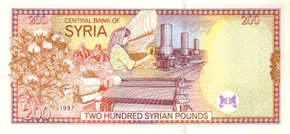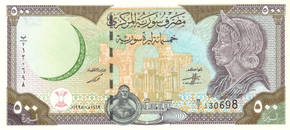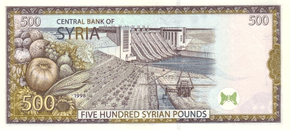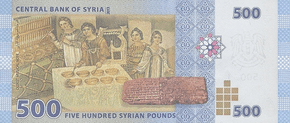Syrian pound
The Syrian pound or Syrian lira (Arabic: الليرة السورية al-līra as-sūriyya; French: livre syrienne; sign: LS or £S; code: SYP) is the currency of Syria and is issued by the Central Bank of Syria. The pound is subdivided into 100 qirsh (قرش, plural: قروش, qurūsh, piastres in English or French), although coins in qirsh are no longer issued. The standard abbreviation for the Syrian pound is SYP.
| Syrian pound | |
|---|---|
| الليرة السورية (in Arabic) | |
 1000-pound banknote | |
| ISO 4217 | |
| Code | SYP |
| Denominations | |
| Subunit | |
| 1⁄100 | piastre |
| Symbol | LS or £S |
| Banknotes | 50, 100, 200, 500, 1000, 2000 pounds |
| Coins | 5, 10, 25, 50 pounds |
| Demographics | |
| User(s) | |
| Issuance | |
| Central bank | Central Bank of Syria |
| Website | Banque Centrale Syria |
| Valuation | |
| Inflation | 25.5% |
| Source | The World Factbook, 2017 est. |
| Value | 1256 SYP = 1 USD (official) 2550 SYP = 1 USD (free market) As of 27 June 2020 |
Before 1947, the word qirsh was spelled with the initial Arabic letter غ, after which the word began with ق. Until 1958, banknotes were issued with Arabic on the obverse and French on the reverse. After 1958, English has been used on the reverses, hence the three different names for this currency. Coins used both Arabic and French until independence, then only Arabic.
On 5 December 2005, the selling rate quoted by the Commercial Bank of Syria was 48.4 SYP to the US dollar. A rate of about 50 pounds to one dollar was usual in the early 2000s, but the exchange rate is subject to fluctuations. Since the start of the civil war in 2011, the pound's unofficial exchange rate has deteriorated significantly, falling from 47 SYP = US$1 in March 2011 to 515 SYP in July 2017 and 765 SYP in November 2019. The black-market exchange rate was 950 SYP to 1 USD on 2 December 2019,[1] while the official rate by the central bank was 434 SYP for 1 USD.
History
During the period when Syria was a part of the Ottoman Empire, which lasted about 400 years, the Ottoman lira was its main currency. Following the fall of the Ottoman Empire and the placing of Syria under a mandate (French occupation), the Egyptian pound was used in the territories under French and British mandates, including Lebanon, Transjordan and Palestine. Upon taking Lebanon and Syria under its separate mandate, the French government sought to replace the Egyptian currency and granted a commercial bank, the Banque de Syrie (a French affiliate of the Ottoman Bank), the authority to issue a currency for territories under its new mandate.
The pound (or livre as it was then known) was introduced in 1919 and was pegged at a value of 20 French francs.[2] As the political status of Lebanon evolved, the Banque de Syrie, which was to act as the official bank for Lebanon and Syria, was renamed the Banque de Syrie et du Grand-Liban (BSL). BSL issued the Syro-Lebanese pound for 15 years, starting in 1924. Two years before the expiration of the 15-year period, BSL split the Lebanese-Syrian currency into two separate currencies that could still be used interchangeably in either state. In 1939, the bank was renamed the Banque de Syrie et du Liban.
In 1941, the peg to the French franc was replaced by a peg to the British pound of 8.83125 Syrian pounds = 1 British pound, as a consequence of the occupation of Syria by British and Free French forces. This rate was based on the pre-war conversion rate between the franc and sterling. In 1946, following devaluation of the franc, the pound was pegged once again to the franc at a rate of 1 pound = 54.35 francs. In 1947, Syria joined the International Monetary Fund (IMF) and pegged its currency to the U.S. dollar at 2.19148 pounds = 1 dollar, a rate which was maintained until 1961. The Lebanese and Syrian currencies split in 1948. From 1961, a series of official exchange rates were in operation, alongside a parallel, black market rate which reflected the true market rate for Syrian pounds in Jordan and Lebanon where there was a healthy trade in the Syrian currency. The market was allowed to flourish because everybody, including government and public sector companies, needed it. The black market rate diverged dramatically from the official rate in the 1980s.[3] In July 2017, the currency was pegged to the IMF SDF (Special Drawing Rights).[4]
Syrian Civil War

There was a capital flight to nearby countries, including Lebanon, Jordan, Egypt and Turkey, as a result of the Syrian Civil War that started in 2011. In addition, Syria has been subject to sanctions imposed by the United States, the European Union and other countries, which shut Syria out of the global financial system. To circumvent the sanctions, Syrians effected foreign transactions through banks in neighbouring countries, especially Lebanon.[5] As a result, the official exchange rate has deteriorated significantly, falling from 47 SYP = US$1 in March 2011[6] to 515 SYP = US$1 in July 2017.
On 29 November 2019, the exchange rate was 765 SYP = US$1 following the Lebanese protests, a decrease of 30% since the turmoil started a month earlier, as the protests led Lebanese banks to impose tight controls on hard currency withdrawals and transfers abroad, making it hard for Syrians to access funds held by them in those banks.[2][5] The rate fell to 950 SYP on 2 December 2019, another 25% decrease.[1] On 13 January 2020, the currency deteriorated further, as more than 1000 SYP was traded for US$1 in the black market, despite being valued at 434 SYP = US$1 by the Syrian Central Bank.[7] During the COVID-19 pandemic in Syria, the Syrian pound continued to devaluate against the U.S. dollar in the black market, where US$1 equaled more than 1600 SYP in May 2020.[8] A month later, the Syrian pound hit a record low, passing 2000 against the dollar.[9][10] A few days later, the Syrian pound passed 3000 against the dollar.[11] Upon the implementation of the U.S. sanctions related to the Caesar Act, anti-government local authorities in Idlib Governorate adopted the Turkish lira in place of plummeting Syrian pound.[12]
Coins
In 1921, cupro-nickel 1⁄2 qirsh coins were introduced, followed in 1926 by aluminium bronze 2 and 5 qirsh. In 1929, holed, nickel-brass 1 qirsh and silver 10, 25 and 50 qirsha were introduced. Nickel-brass 1⁄2 qirsh were introduced 1935, followed by zinc 1 qirsh and aluminium-bronze 2½ qirsh in 1940. During the Second World War, brass 1 qirsh and aluminium 2 1⁄2 qirsh emergency coins were issued. These pieces were crudely produced and undated.
A new coinage was introduced between 1947 and 1948 in denominations of 2 1⁄2, 5, 10, 25 and 50 qirsha and 1 pound, with the 2 1⁄2, 5 and 10 qirush struck in cupro-nickel and the others in silver. Aluminium-bronze replaced cupro-nickel in 1960, with nickel replacing silver in 1968. In 1996, following high inflation, new coins were introduced in denominations of 1, 2, 5, 10 and 25 pounds, with the 25 pounds a bimetallic coin. In 2003 5, 10, and 25 pound coins were issued, with latent images. On December 26, 2018, the Central Bank of Syria introduced a 50 Syrian pounds coin for general circulation and to also replace the banknote of said denomination.[13]
Banknotes

In 1919, the Banque de Syrie introduced notes for 5, 25 and 50 qirsha, 1 and 5 livres. These were followed, in 1920, by notes for 1 qirsh and 10, 25, 50 and 100 livres. In 1925, the Banque de Syrie et du Grand-Liban began issuing notes and production of denominations below 25 qirsha ceased. Notes below 1 livre were not issued from 1930. In 1939, the issuing body again changed its name, to the Banque de Syrie et du Liban.
Between 1942 and 1944, the government introduced notes for 5, 10, 25 and 50 qirsha. In the early 1950s, undated notes were issued by the Institut d'Emission de Syrie in denominations of 1, 5, 10, 25, 50 and 100 livres, followed by notes dated 1955 for 10 and 25 livres. The Banque Centrale de Syrie took over paper money issuance in 1957, issuing the same denominations as the Institut d'Emission.
In 1958, the French language was removed from banknotes and replaced by English. Notes were issued for 1, 5, 10, 25, 50, 100 and 500 pounds. In 1966, the design of the 25, 50, and 100 pound notes was changed. In 1976 and 1977, the designs changed for all the denominations except the 500-pound note. In 1997 and 1998, a new series of notes was introduced in denominations of 50, 100, 200, 500 and 1000 pounds, with the lower denominations replaced by coins. In 2009, the 50, 100, and 200 pound notes were changed with an entirely new design.[14] In 2014 a new 500 pound note has been released, followed by a new 1000 note in 2015. The all-new 2000 pound note was introduced in July 2017.
| 50 pounds | |
|---|---|
  | |
| Arabic obverse: Citadel of Aleppo and the Norias of Hama. | English reverse: al-Assad National Library and the Abbasiyyin Stadium. |
| 100 pounds | |
|---|---|
  | |
| Arabic obverse: Philip the Arab and the Roman theatre of Bosra. | English reverse: The Hejaz Train Station of Damascus. |
| 200 pounds | |
|---|---|
  | |
| Arabic obverse: Statue of Saladin and the Tomb of the Unknown Soldier in Damascus. | English reverse: Cotton weaving; energy plant |
| 500 pounds | |
|---|---|
  | |
| Arabic obverse: Zenobia and the columns of Palmyra. | English reverse: Tabqa Dam. |
| 1000 pounds | |
|---|---|
  | |
| Arabic obverse: former president Hafez al-Assad and the Umayyad Mosque. | English reverse: Oil industry of Syria, combine harvester, ship. |
2010 series
On July 27, 2010, the Central Bank of Syria issued a new series of banknotes dated 2009 in denominations of 50-, 100-, and 200 pounds. The notes were designed by Austrian banknote designer Robert Kalina.[15] The Central Bank of Syria issued new 500-pound and 1000-pound notes in 2014 and 2015, respectively. The reverse of the new 1000-pound note features an image of a Roman mosaic painting discovered in Deir al-Adas.[16] President Bashar al-Assad was added to the 2000-pound note in 2017.
| 50 pounds | |
|---|---|
  | |
| Arabic obverse: A rectangular Ugarit tablet of first Abjad, and a circular Ebla tablet. | English reverse: Al-Assad National Library and a statue of Hafez Al-Assad. |
| 100 pounds | |
|---|---|
  | |
| Arabic obverse: Archway of main gate and Roman Theatre at Bosra. | English reverse: The dome of the Treasury from the Umayyad Mosque in Damascus, Central Bank of Syria headquarters building, ancient coin of Philip. |
| 200 pounds | |
|---|---|
  | |
| Arabic obverse: Norias of Hama. | English reverse: Ceiling of Temple of Bel in Palmyra. |
| 500 pounds | |
|---|---|
  | |
| Arabic obverse: Damascus Opera House. | English reverse: "Mosaic of the Musicians" from a Byzantine villa in Maryamin.[17] The clay tablet depicts the Hurrian songs, the oldest surviving substantially complete work of notated music, found in Ugarit. |
| 1000 pounds | |
|---|---|
  | |
| Arabic obverse: Roman Theatre at Palmyra. | English reverse: Roman mosaic of a grape harvest in Deir al-Adas. |
| 2000 pounds | |
|---|---|
  | |
| Arabic obverse: President Bashar al-Assad and the Umayyad Mosque. | English reverse: Interior of the People's Council of Syria. |
See also
| Current SYP exchange rates | |
|---|---|
| From Google Finance: | AUD CAD CHF EUR GBP HKD JPY USD TRY JOD |
| From Yahoo! Finance: | AUD CAD CHF EUR GBP HKD JPY USD TRY JOD |
| From XE.com: | AUD CAD CHF EUR GBP HKD JPY USD TRY JOD |
| From OANDA: | AUD CAD CHF EUR GBP HKD JPY USD TRY JOD |
| From fxtop.com: | AUD CAD CHF EUR GBP HKD JPY USD TRY JOD |
Notes
- "Syrian pound hits record low in panic selling, dealers say". Reuters. 2 December 2019.
- "Syria (barely) survived a civil war. Can it weather the latest financial crisis?". Los Angeles Times. 29 November 2019.
- Syria: The businessman can't play his hand Euromoney May 1986.
- Syria ends pound's peg to U.S. dollar BLOOMBERG MARCH 27, 2017
- "Lebanon crisis wreaks havoc on Syria's war-torn economy". Reuters. 29 November 2019.
- أرشيف أسعار العملات الأجنبية عام 2011 (XLS) (in Arabic). Central Bank of Syria. 2011. Retrieved 27 September 2016.
- "Syrian Pound Hits Record Low of 1,000 against the Dollar". Asharq Al-Awsat. 13 January 2020.
- "Syrian pound continues to devaluate against USD". Xinhuanet. 17 May 2020.
- "Syrian pound passes 2000 against dollar as new policies fail to stop freefall". Syria direct. 3 June 2020.
- "Syrian pound hits record low against dollar in panic trading, dealers say". Reuters. 4 June 2020. Retrieved 4 June 2020.
- "Syrian pound hits record low ahead of new U.S. sanctions: dealers". Reuters. 9 June 2020.
- "Syria's Idlib adopts Turkish lira in place of plummeting pound". France 24. 15 June 2020.
- 50 Liras Numista (https://en.numista.com). Retrieved on 2020-05-20.
- Linzmayer, Owen (2013). "Syria". The Banknote Book. San Francisco, CA: www.BanknoteNews.com.
- Syria new 50-, 100-, and 200-pound notes confirmed BanknoteNews.com. July 27, 2010. Retrieved on 2013-02-19.
- CBS puts into circulation new SYP 1,000 banknotes to replace worn-out currency
- Ring, Trudy (1994), International Dictionary of Historic Places: Middle East and Africa, 4, Taylor & Francis, ISBN 1884964036
References
- Krause, Chester L.; Clifford Mishler (1991). Standard Catalog of World Coins: 1801–1991 (18th ed.). Krause Publications. ISBN 0873411501.
- Pick, Albert (1994). Standard Catalog of World Paper Money: General Issues. Colin R. Bruce II and Neil Shafer (editors) (7th ed.). Krause Publications. ISBN 0-87341-207-9.